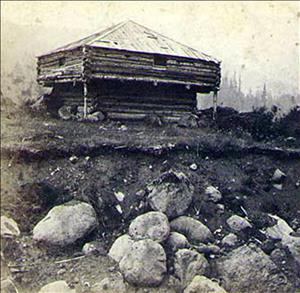On March 26, 1856, warriors of the Yakama, Klickitat, and Cascades tribes attack Americans at the Cascades of the Columbia, killing 14 civilians and three soldiers. Indians besiege settlers overnight until soldiers from The Dalles relieve them. The incident will be called the Cascades Massacre and is the costliest event in terms of white casualties during the Yakama Indian War of 1855-1856.
In 1855, Indians in Washington Territory went to war with American settlers over treaties that removed the tribes to reservations. In March 1856, Yakama Chief Kamiakin (ca. 1800-1877) plotted to attack the Americans who operated the portage at the Cascades of the Columbia. The Cascades was an important salmon fishery from which the Indians gathered most of their food for a year. American officers learned that by controlling the best fishing locations they could deny the Indians their economic and nutritional foundation.
Besides Yakamas, Kamiakin recruited Klickitats and Cascades into the attack plan. By destroying the blockhouses, supplies, tramway, and steamships, the tribes could cripple American military operations east of the Cascade Mountains.
On March 25, 1856, Colonel George Wright (1803-1865) and three companies of his newly organized 9th U.S. Infantry Regiment crossed the Cascades en route to Eastern Washington. He left behind at the Cascades of the Columbia nine soldiers to assist the settlers in defending the vital portage. On March 26 Wright's force was five miles above The Dalles.
The Indians, mostly Klickitats, attacked on the morning of March 26th, with assaults on the Upper, Middle, and Lower Cascades. At the Lower Cascades most of the whites had started work on two bridges for the portage railroad. It was here that most of the whites died. Some settlers fled to the safety of a blockhouse near Fort Rains, on the Middle Cascades. Others took shelter in a sturdy, two-story store at the Upper Cascades, owned by brothers Daniel and Putnam F. Bradford. Settlers below the landing fled downriver in boats. The attackers failed to trap the steamers Mary and Wasco above the Cascades and the crews, some of them wounded, got up steam and headed upriver to find Colonel Wright.
By late in the day, some 40 men, women, and children were huddled in the Bradford store. As they watched, the Indians burned a sawmill and lumberyard owned by the Bradfords, along with several houses and a warehouse under construction. The Indians threw firebrands onto the roof of the store in an effort to burn it as well, but the refugees managed to douse the flames.
On March 27, 40 (some say 20) mounted soldiers, called dragoons, arrived aboard the steamer Belle from Fort Vancouver under Lieutenant Phil Sheridan (1831-1888). Sheridan attempted to attack Indians engaged in horse races at the upper landing, but his movement was compromised by bugles from Brevet Lieutenant Colonel Edward Steptoe's (1816-1865) column from up river. The Yakamas fled, leaving the Cascades behind. The Cascades surrendered without a fight.
Wright arrived on the March 28 and charged the prisoners with treason. (The Indians were captives. They were not citizens of the United States and could not properly be charged with treason.) Wright's military commission found nine Cascades, including Chief Chenoweth, guilty, based on their freshly fired rifles and their own statements. Each condemned man was positioned on a barrel, a rope affixed around his neck, and the barrel kicked out from under him. Chief Chenoweth gave a war whoop and shouted, "I am not afraid to die!" As he slowly strangled he was killed with a bullet.
Joseph L. Meek (1810-1875), a former U.S. Marshal for Oregon and serving as an officer of volunteers, inquired after the family of Spencer, a Chinook chief who served as Colonel Wright's interpreter. Spencer had sent them back to Fort Vancouver just before the attacks. The family -- Spencer's wife, two boys, three girls, and an infant -- were found strangled near the Cascades three weeks later. In his memoirs, Lieutenant, later General, Sheridan implicated members of the Oregon volunteers in these killings, but the men were never brought to justice.
The Cascades of the Columbia became the site of Bonneville Dam in 1934.

